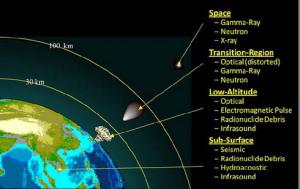Nuclear detectionLooking from space for nuclear detonations
Sandia has been in the business of nuclear detonation detection for more than fifty years, starting with the 1963 launch of the first of twelve U.S. Vela satellites to detect atmospheric nuclear testing and verify compliance with the Limited Test Ban Treaty of 1963 and subsequently the Threshold Test Ban Treaty of 1974. That marked the start of the U.S. Nuclear Detonation Detection System that supports treaty monitoring. The Global Burst Detection (GBD) system launched 5 February from Cape Canaveral aboard the 70th Global Positioning System (GPS) satellite. The GBD looks for nuclear detonations around the world, offering real-time information about potential activity to U.S. policymakers. The launch was the 12th and final of the Block IIF (GPSIIF) series of GPS satellites in medium Earth orbit.

Phenomonology of nuclear explosions // Source: nap.edu
Sandia National Laboratories’ Jaime Gomez was too busy to celebrate the successful launch of the latest nuclear detonation detection system — he was already deep into the next generation.
The Global Burst Detection (GBD) system launched 5 February from Cape Canaveral aboard the 70th Global Positioning System (GPS) satellite. The GBD looks for nuclear detonations around the world, offering real-time information about potential activity to U.S. policymakers.
Sandia Lab says that as project lead, Gomez oversaw teams responsible for everything from development to post-launch testing. The launch was the 12th and final of the Block IIF (GPSIIF) series of GPS satellites in medium Earth orbit.
Project Manager Bridget McKenney said that even before the final GPSIIF launch, Sandia was producing and delivering another generation of GBDs for a new round of eight satellites, GPSIII, which Lockheed Martin Corp. is building. Sandia is already looking ahead to detectors for the launch series after that, dubbed Prime.
“We work ten years ahead, from the time we get a concept for what the next generation of improved technologies and sensing will be,” McKenney said. Each GBD program starts with the initial concept, followed by approvals, engineering development, an extensive and complex design cycle and production and testing. The work is funded by the National Nuclear Security Administration.
Sandia has been in the business of nuclear detonation detection for more than fifty years, starting with the 1963 launch of the first of twelve U.S. Vela satellitesto detect atmospheric nuclear testing and verify compliance with the Limited Test Ban Treaty of 1963 and subsequently the Threshold Test Ban Treaty of 1974. That marked the start of the U.S. Nuclear Detonation Detection System that supports treaty monitoring.
GPSIII scheduled to launch next year
Defense Support Program satellites followed, succeeded by the earliest GPS satellites in 1978. The first of the IIF series was launched in 2010. The first GPSIII is scheduled to launch in 2017.
From the start, GPS satellites were seen as an ideal platform to look for nuclear detonations. Gomez said the sheer numbers planned meant there always would be many GBD systems in space, a detection redundancy highly prized during the cold war. Today, GPS satellites are important for treaty verification and countless civilian uses, including timing signals for communications networks, financial markets and power grids, ship navigation and even pinpointing where crops might need more water or fertilizer.
